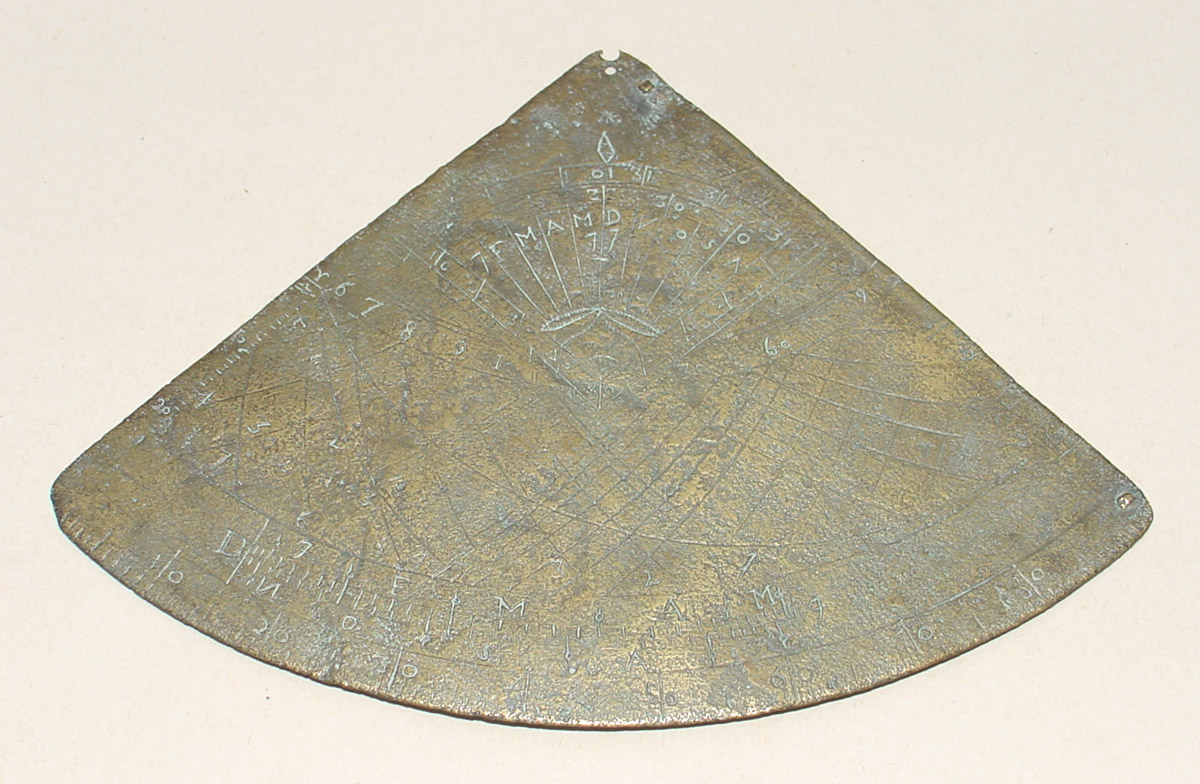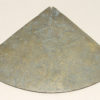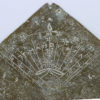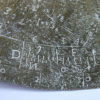FASCINATING EARLY QUADRANT
Stock Number: 7077
$4500.
For sale, antique, 17th century English quadrant. Very thin brass, hand engraved with scales for measuring angular altitude of sun, moon, stars, etc. Also carries a calendrical scale, sky grid and other complex scales.
Dimensions
3-3/4" (9.5 cm) radius
Circa
c. mid-17th century
Country of manufacture
UK and Ireland
Description
FASCINATING EARLY QUADRANT, English, mid-17th century. This very thin brass quadrant is 3-3/4″ (9.5 cm) in radius, hand engraved on one side, with practice engraving of several numerals and letters on the reverse. There is a circumferential quadrant scale divided every degree, for use in measuring the angular altitude of sun, moon, stars, mountains, buildings, etc., by sighting along the edge and reading against a little plumb line which would be suspended from the apex. Next is a calendrical scale, laid out for a vernal equinox of approximately 11 March (consistent with the Julian calendar), and for a latitude of 52° (close to that of London). The sky grid of arcuate hour and azimuth lines is crossed by the ecliptic, and is consistent with Edmund Gunter’s design of 1623. There is an edge scale of solar declination, and in the corner a fascinating shadow square, each leg divided every 5 from 0 to 50. Within the square is a shape of calendar scale not seen by us on surviving quadrants. The 90° angle is divided radially into ten equal segments labeled “J, F, M, A, M, D, N, O, S, A,” and with “J, J” on the center line. And concentric arcs indeed carry variously the numbers 28, 30, and 31, which all align, rather primitively, with the letters, giving an aide-mémoire for the number of days in each month. The apex of the square has hand-engraved decoration of a very distinctive style found on some 17th and early 18th century English instruments: compare with that on a plane table rule (Tesseract Catalogue 76, Item 30) and that on a boxwood compendium attributed to Sutton (Wynter and Turner, p. 132). Condition is fair noting much old pitting to the brass, and only remnants of the little pinhole sights remaining. The instrument was reputedly purchased in Wales many decades ago, and probably suffered outdoor weathering a very long time before. Nevertheless it is a fascinating early quadrant.
Ask the Dealer
Dealer information
 TESSERACT
TESSERACT
David and Yola Coffeen both have enjoyed academic careers, as planetary astronomer and as linguist/educator. But since 1982 (yes, 1982!) they have been full-time dealers in early scientific and medical instruments, under the name Tesseract. Selling primarily by catalogue (over 100 issued so far) they also have a web presence at www.etesseract.com, and can be contacted at [email protected].








